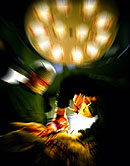
WEDNESDAY, Feb. 9 (HealthDay News) — Surgery to address the most serious form of the spinal cord birth defect known as spina bifida may be most effective if performed on the fetus, new — and potentially groundbreaking — research suggests.
When successful, the surgery could mean the difference between a life spent on crutches or not, experts say, since twice as many spina bifida-affected children ended up walking on their own after the fetal surgery versus those who were operated on after birth.
But the delicate prenatal procedure also comes with hazards, including much higher odds for premature delivery and its attendant problems for newborns.
“While this is a very promising and quite exciting result for this disease, which is otherwise a very neglected disease, not all the patients were helped here, and there are significant risks,” study senior author Dr. Diana Farmer, division chief of pediatric surgery at the University of California San Francisco, as well as surgeon-in-chief at UCSF Benioff Children’s Hospital, said at a news conference held Wednesday. “So this procedure is not for everyone,” she cautioned.
Nevertheless, Farmer added that “it would be responsible to inform families that this [prenatal approach] would represent an additional option in care that they can consider.”
Surgery for this “myelomeningocele” form of spina bifida is designed to close up an abnormal opening at the back of the baby’s spine. The opening results in spinal cord protrusion, which can alter the movement of spinal fluid and wrench the brain stem down into the skull’s base, a development known as “hindbrain herniation.”
Surgery to correct the condition has traditionally been performed after birth.
However, the new report, published online Feb. 9 in the New England Journal of Medicine, suggests that delicate surgery performed in utero actually reduces the subsequent post-delivery need for “shunting,” or diverting, of fluid away from the child’s brain.
The myelomeningocele form of spina bifida occurs in 3.4 of every 10,000 births, according to background information in the study. The literal translation of spina bifida is “split spine,” Dr. Alan E. Guttmacher, director of the Eunice Kennedy Shriver National Institute of Child Health and Human Development (NICHD) at the U.S. National Institutes of Health, said at the press conference. He noted that this “neural tube” defect — which occurs early in embryonic development — typically gives rise to significantly impaired infant motor function. Bladder and bowel control are also compromised, and in its most severe form the defect prompts serious weakness and/or full paralysis below the spinal cord opening.
Hindered spinal fluid circulation can ultimately be life-threatening, the researchers noted, and 10 percent of infants with the myelomeningocele form of spina bifida die.
To explore a potentially better way to treat the defect, the team worked with 183 expectant mothers, all of whom were carrying children affected by the defect and hindbrain herniation.
The women were divided into two groups: one set to undergo a one- to two-hour prenatal surgery between 19 and almost 26 weeks of gestation, and one to undergo a similar post-delivery surgery.
All of the offspring were then examined at 1 year of age, and then again at 2.5 years of age.
Farmer noted that by year one, two infant deaths had occurred in each of the two groups.
Nevertheless, the research team observed that the combined risk for either death or a need for a shunt to divert brain fluid by 1 year of age was much lower among infants who had undergone the in-utero surgery (almost 68 percent), compared with those in the post-delivery group (about 98 percent).
Children in the prenatal surgery group also fared 21 percent better on scores assessing mental development and motor function by the 2.5-year mark, compared with the post-delivery surgery group.
And while only around 21 percent of children in the post-delivery surgery group were ultimately able to walk without orthotics or crutches, that figure rose to nearly 42 percent among those in the prenatal surgery group.
Speaking at the press briefing, Dr. Catherine Y. Spong, chief of the NICHD’s pregnancy and perinatology branch, described one other “remarkable finding”: By 1 year of age, more than one-third of the children in the prenatal surgery group showed no signs of hindbrain herniation, compared to just a little more than 4 percent of those in the group who underwent surgery after delivery.
But there were hazards, as well — children who underwent the prenatal procedure were more likely to be born preterm, at an average of 34.1 weeks, compared with 37.3 weeks among the post-delivery group.
“Prematurity is a significant risk,” noted Farmer, who added that such a development can prompt the onset of dangerous respiratory distress syndrome. In fact, nearly 21 percent of the prenatal group had signs of this breathing disorder, compared with only about 6 percent in the post-birth surgery group.
In addition, mothers in the prenatal group faced a higher risk for uteral thinning, with one-third experiencing thinning at delivery.
“Even though the children who underwent the surgery in uterus did much better overall, these risks both to the fetus and the mother cannot be ignored,” said Farmer.
The research team also cautioned that not all women are ideal candidates for the surgery. Specifically, those determined to be severely obese (with a body mass index over 35) were not included in the study — a criteria that the authors suggested could exclude about 10 to 13 percent of women. Down the road, this obstacle could prove problematic, since maternal obesity is a known risk factor for spina bifida in offspring.
The study also involved researchers from the Vanderbilt University Medical Center in Nashville and the George Washington University Biostatistics Center in Washington, D.C.
More information
For more on spina bifida, visit the U.S. National Library of Medicine.

